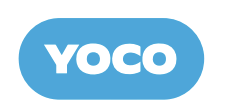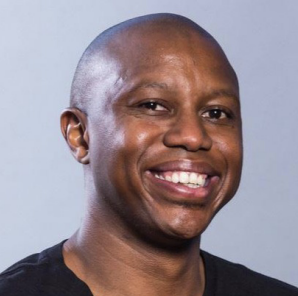

Decoupling long-range and short-range orientation inside the structure unlocks energy as you can tackle the long term without compromising the immediate needs of the short term. ,
Headquartered in Cape Town, South Africa, Yoco was founded in 2015 and has grown to become South Africa’s leading mobile payments solution. CEO Katlego Maphai engaged with Lex and Organizational Physics to conduct a strategic alignment and organizational redesign program in 2018. At that time, the company was at $9.1M in sales and 115 employees. Three years later, at the time of publication of this book, Yoco is at $35M in sales, has a 10-member Leadership Team and 250 employees, and through its Small Business Recovery Monitor, it has been instrumental in helping the South African government to navigate the economic impact of its COVID-19 response. This is CAGR of 56%. Let’s hear directly from Katlego.
Yoco didn’t start with an idea. It began with the meeting of minds. A diverse group of friends from different walks of life and on the same wavelength came together. All tired of the status quo in an unequal country, they gathered with a common purpose to remove barriers, level the playing field, and enable people to thrive. This group of friends were Katlego, Lungisa, Bradley, and Carl.
Lungisa and Katlego knew each other from childhood in the early ‘90s in Cape Town. They both eventually left the city as kids, and after many years away, randomly reconnected at the University of Cape Town while queuing to register for their faculty. Carl and Katlego met Telecoms Advisory and Investment firm Delta Partners in 2009. Bradley and Katlego met at Rocket Internet to incubate Kasuwa in Lagos in May 2012, which eventually rebranded to Jumia.
Katlego had first seen Square, the US pioneer in the mobile point of sale space, in 2011 during an annual visit to San Francisco. A year later, he saw it everywhere. The lightbulb moment or propagation of the seed saw an African American lady running a run-down eatery with great BBQ take payment for a $40 basket size. The lady processed the transaction on a low-end Android phone with ease. At that moment, a lightbulb switched on. Mobile technology was empowering the small business owner. At the same time, the environment no longer felt like a hole in the wall. It felt like a business. The applicability of the product and its potential impact on small traders in Africa slowly started to form. Something that stayed with Katlego even as he got going at Rocket Internet.
All on sabbatical, after Bradley and Katlego returned from their Rocket Internet stint in Lagos, the four started spending time together socially and knew they wanted to work on something entrepreneurial together. They didn’t know what but, importantly, knew why. They began to explore different business ideas but kept circling back to the mobile point-of-sale model pioneered by Square and that was picking up steam in Europe with iZettle and SumUp.
In late 2012, various opportunities in the burgeoning space availed themselves. The tipping point was when they started to size the problem and opportunity to solve the payment acceptance gap. They realized that millions of businesses in South Africa lacked access to electronic payments, despite more than three quarters of adult consumers carrying a card. When they started to plunge deeper into the problem, they found that banks made it challenging and a privilege for businesses to get a card machine.
First, you needed to call your bank and make an appointment with a salesperson after answering some pre-qualifying questions, including your monthly turnover. Naturally, the reprioritization of smaller businesses took place. Six months of trading history were required, which excluded start-ups when they needed the most help to get going. Salespeople focused on the urban commercial areas, which excluded businesses on the urban fringes and smaller towns. You had to take out a 24-month contract, at $40 per month, just to rent the terminal and commit to minimum transaction volumes off the back of steady revenues. Pricing was opaque, creating asymmetry in negotiations and ultimately disfavoring smaller businesses.
With their background in mobile telecoms, they asked the simple question: Why could you walk into a carrier, fill in a form, get vetted, leave with a new phone and SIM card, and make phone calls on the day, while for a card machine, a similar business model of transacting (spending minutes), you waited weeks if you were lucky to be approved by your bank? Early in 2013, they incorporated Yoco and moved to Johannesburg to start an odyssey to get a license to operate in an oligopolistic environment and get going. A year later, they got the license sponsorship, closed a seed round to get going. They moved back to Cape Town and started building Yoco with the early team in 2014. The rest is history, yet it is still the beginning.
The second quarter of 2018 was a challenging time with growing pains and the need to transition with a lack of support/ideas to take things forward. We were in the middle of a Series B roadshow, with six months of runway. A couple of dynamics were at play, which needed attention.
Alongside the transformation work and workshops that we conducted with Lex, we ran a concurrent exercise to surface/articulate our vision, purpose, and core values. Combining these foundational activities resulted in an incredible shift at the organization that continues to resonate today.
Work on the strategy
We learned how to define strategic priorities using a simple SWOT framework (Entropy Survey), ensuring we set imperatives that addressed both the environment and what needed to happen on the inside to maximize flow. Before this, we only tackled strategy with an external lens. We radically simplified how we defined and measured objectives, learning to say “no.” We also assigned an accountable person to the imperatives. With this as a baseline, we could better communicate and translate the strategy to the organization. We had one unifying goal to move us forward.
Work on the structure
Shortly after completing work on strategy, we moved forward to work on structure immediately. Applying some counterintuitive principles to defining the structure manifested in splitting up some areas that would typically fall under the same function. Two examples that stand out relative to the challenges we were facing at the time include:
Splitting brand marketing and demand generation marketing
In terms of solving the user growth challenge, decoupling brand marketing (longer-range focus) from demand generation marketing (shorter range focus) was a game-changer. With a longer term orientation, the brand team developed the Yoco brand, consistently putting out magical campaigns that have set the bar in the market for the SMB segment we serve. The demand generation team became focused exclusively on lead generation off the back of the audience-building work conducted by the brand team. Integrated campaigns amplified lead generation and general credibility/trust as potential users engaged with the brand across channels. As such, user growth has continued to double year on year with this winning combination.
Splitting product strategy and product management
Splitting product strategy (longer-range) and product management (shorter-range) meant that we could define and develop a product roadmap over a longer horizon without compromising what needed to happen in the next quarter. This orientation allowed us to take on longerterm, CAPEX-intensive projects to develop our core payments platform. We set out to build our payment stack to replace the third party we employed to address the quality-of-service issues with our payments experience. At the start of 2019, we kicked off a significant program to construct a new payment switch and payment hardware integration capability, a substantial and complex undertaking requiring a longterm view. Ambitiously, a new valuable piece of infrastructure was built in record time, ushering the organization into the future. It triggered a vertical integration program that will define the organization over the long term. We achieved all this without compromising short-range priorities. In 2019 we broke multiple sales and usage records.
Work on how we engaged
Reconstitution of the leadership team. A new leadership team emerged from the new structure. Accountability and expectations were clear, creating room for authority and autonomy to be present across the functions. Alongside this, Lex introduced us to a new format to come together in a weekly leadership team meeting to engage, build shared consciousness and, importantly, take meaningful decisions in a structured way. In this forum, decisions, reversible and nonreversible, were processed as proposals written in the form of narratives. Proposals are a staple in our weekly cadence. We also took the time to surface tensions across the business and assign clear actions to resolve.
• Lifecycle theory in the context of a business is a remarkable construct to conceive of where you might be, what’s coming next, and what intentions are required to move forward. The strategy map is a powerful tool to contextualize all the primary activities of a company.
• Understanding where teammates can make their most significant contribution alongside the © Organizational Physics Inc. All rights reserved. 7 lifecycle is critical. You see people who thrive in the early stages and those who thrive in the later stages.
• Distinguishing between non-reversible (T1) and reversible (T2) decision-making. Linked to this, the use of proposals in narratives to take decisions and move things forward.
• Thinking about both the outside (environment) and inside (organization) to maximize outcomes for strategic imperatives.
• Decoupling long-range and short-range orientation inside the structure unlocks energy as you can tackle the long term without compromising the immediate needs of the short term.
This case study was originally published in the book Designed to Scale by Lex Sisney.
© Organizational Physics Inc. All rights reserved.
Let’s build your high-performance organization together.
Organizational Physics® empowers CEOs and leadership teams to scale with clarity and confidence. By applying universal principles and proven frameworks, we help organizations improve internal performance, accelerate growth, and build resilient structures for the long term.
© Copyright Organizational Physics Inc.